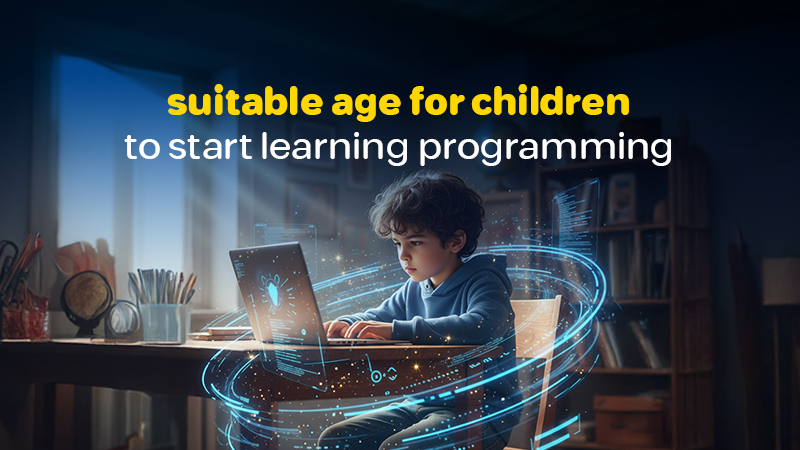.png)
Many parents today wonder how to make the most of their children’s time after school. While sports and arts remain highly valuable, there’s a new activity that combines fun, creativity, and future-ready skills — coding for kids.
A child who spends hours on a screen can become more than just a user — they can turn into a creator of technology when guided through engaging, interactive coding lessons.
Why Coding Is the Perfect After-School Activity
Coding isn’t only about typing technical commands — it’s a hands-on way to develop logical thinking, problem-solving, and creativity.
A 2022 study from the University of Cambridge found that children who learn coding regularly show notable improvement in problem-solving skills and mental flexibility, helping them perform better both academically and in daily life.
Coding also gives kids a strong sense of accomplishment. Seeing their ideas come to life — whether as a simple game or an animated story — keeps them motivated and curious.
From Age 6: Fun and Engaging Coding Lessons
Parents often ask: Can a 5- or 6-year-old really learn to code?
The answer is yes — if it’s taught the right way.
At this age, learning should feel like play. In beginner-friendly programs like Scratch Jr, kids move cartoon characters using simple commands like “jump” or “move forward.”
Though it looks like a game, children are actually learning essential concepts such as:
- Sequencing steps
- Cause and effect
- Logical reasoning
How Coding Boosts Creativity and Thinking Skills
Coding goes far beyond technical learning — it helps kids become innovators.
According to the World Economic Forum’s 2023 report, children who start coding early are up to 40% more innovative than their peers.
It’s also a great way for kids to connect their passions with technology:
- A child who loves drawing can design characters for their games.
- A storytelling enthusiast can turn their ideas into interactive stories.
- A sports lover can build a game to track scores or simulate matches.
iSchool’s Age-Based Coding Programs (6–7, 8–10, 11–14)
Unlike one-size-fits-all programs, iSchool tailors its curriculum to each age group, ensuring every child learns at the right level:
- Ages 6–7: Play-based lessons using animations and fun activities.
- Ages 8–10: Solid coding foundations through games and simple projects.
- Ages 11–14: Advanced skills — like building websites or developing apps.
This structure ensures every child learns at their own pace, gaining confidence and skills step by step.
Why iSchool Stands Out: Interactive Learning with Expert Teachers
What makes iSchool unique is its combination of expert-led instruction and real-time engagement:
- Live online classes with direct teacher-student interaction.
- Specialized instructors trained to teach kids of all ages.
- Hands-on projects that let kids apply what they learn.
- Regular progress reports for parents.
With iSchool, coding isn’t just another extracurricular activity, it’s a complete learning journey that helps children build skills for school and for life.
Enroll Your Child in iSchool: Make After-School Time Fun and Meaningful
Learning to code is no longer optional, it’s a powerful investment in your child’s future.
With iSchool, your child will enjoy every minute after school while gaining valuable digital skills that prepare them to be a creator of technology, not just a user.
Start today enroll your child in iSchool and turn their free time into a creative, rewarding, and future-shaping experience.
Yes, a 6-year-old can pick up coding skills. For extremely young children, reading and typing skills might be a barrier to learning how to code, which can be particularly difficult for those under the age of six. iSchool classes, however, deal with this issue by introducing programming through MIT Scratch and other user-friendly drag-and-drop languages. This strategy enables children to explore the core ideas of coding through engaging and interactive learning techniques.
The difficulty of learning to code varies depending on when, where, and how you learn. However, it is critical to distinguish between simply knowing the fundamentals and genuinely comprehending and utilizing the numerous coding ideas that open the door to limitless possibilities. Our workshops are intended to inculcate in children an appreciation for the beauty of creating their own software as well as to illuminate the seemingly unlimited possibilities that coding expertise may open up.
Your child does not need to be a math prodigy to excel at coding, though they will find it easier to learn if they are. Coding can even improve their academic achievement in subjects like math and English. We stress the development of creativity, logical reasoning, and analytical thinking in our courses, which are critical components for developing robust software, and these talents take precedence over a strong math background.
By demonstrating to kids the power of coding as a tool for letting their imaginations run wild and creating their own enchanted worlds, we aim to inspire them. In addition to teaching the benefits of programming, our courses also promote creativity and self-assurance. We accomplish this by utilizing interesting and interactive programming languages, such as MIT Scratch. Our lessons at iSchool cover a wide range of subjects, such as cartoons, music, painting, storytelling, and much more.
It is best to introduce coding to children through relatable, practical examples such as games, cartoons, and music. Our classes focus on teaching children how to code through the creation of simple games or the use of cartoon characters. These are some examples: Coding for Animation and Storytelling , Art & Music Coding and Game Logical Programming.
Learning to code is not a difficult task. Software development can be done by children as young as five years old. The child's ease of learning is primarily determined by the quality of instructors, projects, and examples available to him or her. Our approach fosters a sense of innovation and creativity in children, making learning an enjoyable and simple experience.


.png)
.png)

